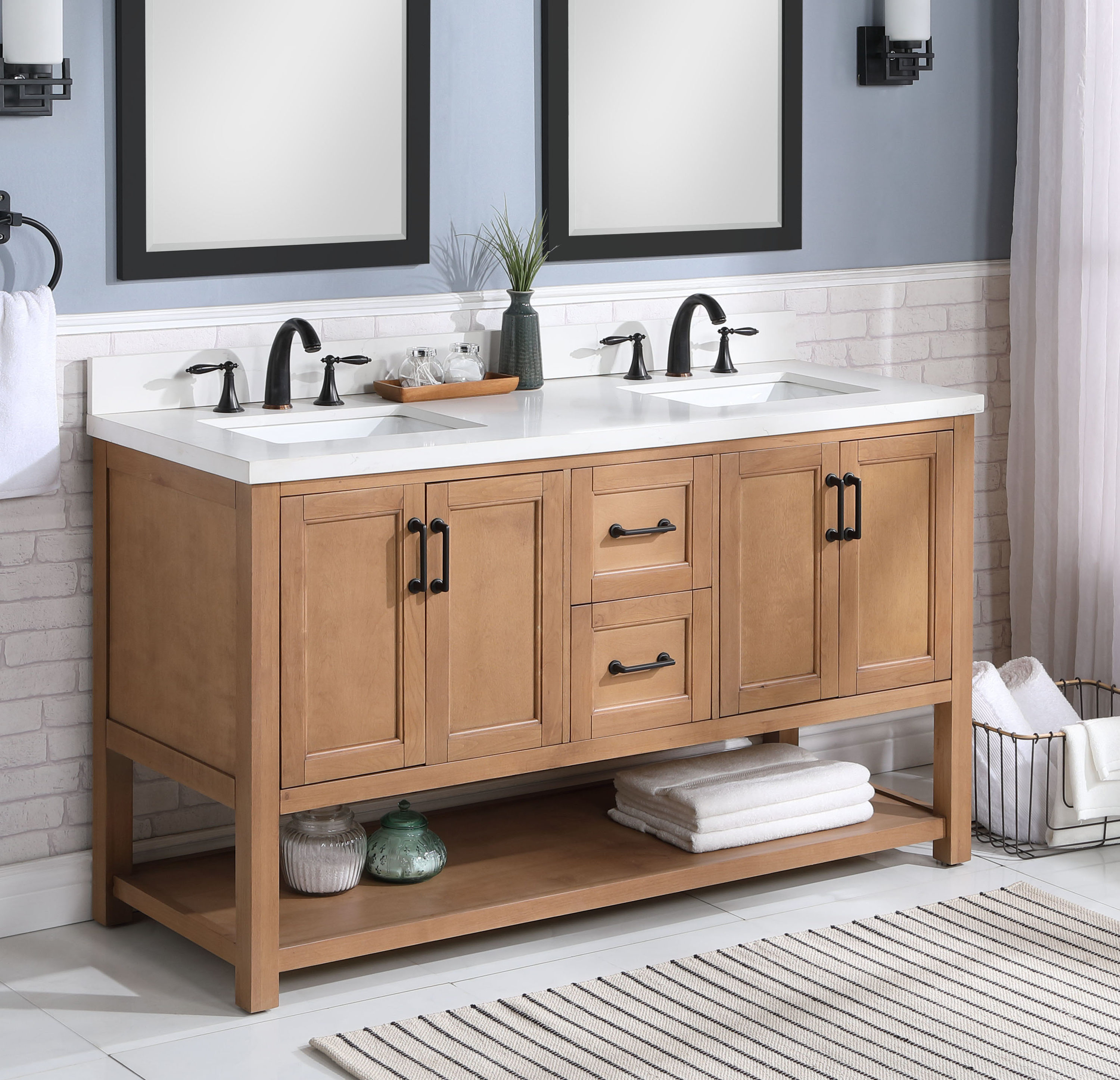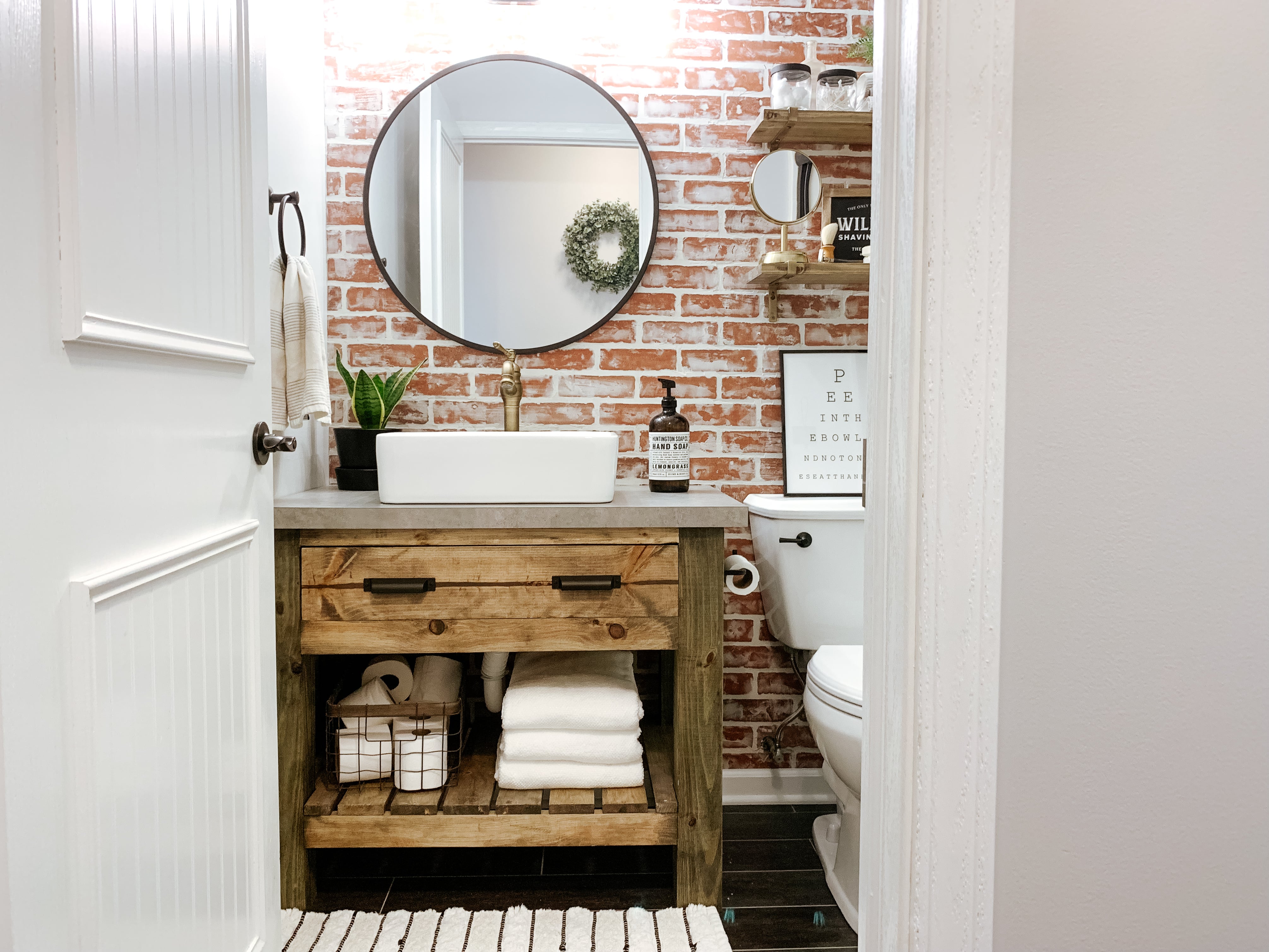Planning an 80 Inch Bathroom Vanity
An 80-inch bathroom vanity offers a significant amount of counter space and storage, making it an excellent choice for larger bathrooms or those with multiple users. However, careful planning is essential to ensure it fits seamlessly into your bathroom and meets your needs.
Advantages and Disadvantages of an 80-Inch Bathroom Vanity
An 80-inch bathroom vanity presents both advantages and disadvantages that should be considered during the planning process.
- Advantages:
- Ample Counter Space: Provides ample counter space for multiple users, accommodating toiletries, styling products, and decorative items.
- Increased Storage: Offers a significant amount of storage space, accommodating towels, linens, and other bathroom essentials.
- Enhanced Functionality: Can be designed with features like double sinks, medicine cabinets, and open shelving to optimize functionality.
- Visual Impact: Creates a statement piece in the bathroom, adding a sense of grandeur and sophistication.
- Disadvantages:
- Space Requirements: Requires a spacious bathroom to accommodate its size and prevent overcrowding.
- Installation Complexity: May require professional installation due to its weight and size.
- Higher Cost: Typically more expensive than smaller vanities due to materials, construction, and potential customization.
- Limited Mobility: May restrict movement within the bathroom, especially in smaller spaces.
Factors to Consider When Planning an 80-Inch Vanity Installation
Careful planning is crucial for a successful 80-inch vanity installation. Consider the following factors:
- Room Size: Ensure your bathroom has enough space to accommodate the vanity without feeling cramped. Allow for at least 30 inches of clearance in front of the vanity and ample space for movement around it.
- Plumbing Access: Determine the location of existing plumbing lines and plan accordingly. If necessary, consult a plumber to ensure proper plumbing connections and drainage.
- Desired Features: Decide on the features you want, such as a double sink, storage options, lighting, and a mirror.
- Style and Design: Select a style and design that complements your bathroom decor and personal preferences. Consider materials, colors, and finishes.
- Budget: Set a realistic budget for the vanity, installation, and any additional features you want to include.
Designing an 80-Inch Vanity Layout
An 80-inch vanity provides ample space for a variety of layout options. Consider these elements:
- Double Sink: A double sink offers convenience for multiple users and provides ample counter space for toiletries and styling products.
- Storage: Maximize storage with drawers, cabinets, and open shelving. Consider a combination of different storage types to accommodate various items.
- Optional Features:
- Mirror: A large mirror above the vanity can enhance the feeling of space and provide ample reflection for grooming.
- Lighting: Install adequate lighting, such as sconces or overhead fixtures, to ensure good visibility while using the vanity.
Choosing Materials and Styles for an 80 Inch Vanity: 80 Inch Bathroom Vanity Plans

An 80-inch bathroom vanity offers ample storage and counter space, making it an ideal choice for larger bathrooms. Selecting the right materials and style for your vanity is crucial to achieving a cohesive and functional design. This section will delve into various materials and styles, providing insights into their characteristics and aesthetic appeal.
Material Comparisons
The material of your vanity significantly impacts its durability, aesthetics, and cost.
- Wood: Natural wood vanities offer timeless elegance and warmth. They come in various species, including oak, maple, cherry, and walnut, each with unique grain patterns and color variations. Wood vanities can be stained or painted to complement your bathroom decor. However, wood is susceptible to moisture damage, requiring regular maintenance and sealing.
- Laminate: Laminate vanities offer a cost-effective alternative to wood, mimicking the look of natural materials like wood, stone, or metal. They are durable and resistant to moisture, scratches, and stains. Laminate vanities are available in a wide range of colors and patterns, making them versatile for different design styles. However, they may not have the same level of natural beauty as wood.
- Stone: Stone vanities, such as granite, marble, or quartz, provide a luxurious and sophisticated look. They are highly durable, heat-resistant, and easy to clean. Stone vanities are available in various colors and patterns, allowing for unique and personalized designs. However, they are significantly more expensive than wood or laminate and require professional installation.
Vanity Styles
Choosing the right style for your 80-inch vanity ensures a harmonious blend with your bathroom’s overall design.
- Traditional: Traditional vanities typically feature intricate carvings, ornate details, and classic finishes. They often have a warm and inviting aesthetic, suitable for creating a timeless and elegant bathroom.
- Modern: Modern vanities prioritize clean lines, simple forms, and minimalist designs. They are characterized by sleek surfaces, geometric shapes, and often feature materials like stainless steel, glass, or high-gloss finishes.
- Contemporary: Contemporary vanities embrace modern elements while incorporating a touch of warmth and personality. They may feature natural materials, organic shapes, and unique design details.
Visual Representation
Imagine an 80-inch vanity crafted from solid oak, showcasing a traditional style. The vanity features two large drawers and two cabinet doors with raised panel detailing, providing ample storage. The countertop is made of polished marble, adding a touch of elegance and sophistication. The vanity is painted in a warm, neutral color, complementing the natural wood grain. The overall design is characterized by classic proportions, intricate details, and a timeless appeal.
Installing an 80 Inch Bathroom Vanity

Installing an 80-inch bathroom vanity is a significant project that requires careful planning and execution. This guide provides a step-by-step approach to ensure a successful installation, addressing plumbing connections, countertop installation, and essential tips for achieving proper leveling and stability.
Preparing for Installation, 80 inch bathroom vanity plans
Before beginning the installation, gather all necessary tools and materials, including:
- Level
- Tape measure
- Pencil
- Stud finder
- Drill
- Screwdrivers
- Wrench
- Pliers
- Caulk gun
- Safety glasses
- Work gloves
- Appropriate fasteners
- Plumbing supplies (if necessary)
It is crucial to ensure that the vanity’s dimensions align with the available space and that the plumbing connections are compatible with the existing system.
Installing the Vanity
- Prepare the Area: Clear the area around the installation site and cover the floor with a drop cloth to protect it from scratches or spills.
- Locate the Studs: Use a stud finder to locate the wall studs for securing the vanity. Mark the stud locations on the wall with a pencil.
- Assemble the Vanity (If Necessary): Some vanities arrive pre-assembled, while others require assembly. Follow the manufacturer’s instructions carefully for assembly.
- Position the Vanity: Carefully position the vanity against the wall, ensuring it is level and centered. Use shims as needed to achieve proper leveling.
- Secure the Vanity: Attach the vanity to the wall using the appropriate fasteners. Secure the vanity to the studs for maximum stability.
Connecting the Plumbing
- Connect the Sink Drain: Connect the sink drain to the vanity’s drainpipe and secure it with the appropriate fittings.
- Connect the Water Supply Lines: Connect the hot and cold water supply lines to the vanity’s faucet. Ensure the connections are tight and secure.
- Test the Plumbing: Turn on the water supply and check for leaks at all connections. Tighten any loose fittings as needed.
Installing the Countertop
- Prepare the Countertop: Measure the countertop to ensure it fits correctly on the vanity. Make any necessary adjustments to the countertop before installation.
- Position the Countertop: Carefully position the countertop on the vanity, aligning it with the edges of the vanity. Use shims as needed to achieve proper leveling.
- Secure the Countertop: Secure the countertop to the vanity using the appropriate fasteners. Consult the manufacturer’s instructions for specific installation details.
- Apply Caulk: Apply a bead of caulk along the seam between the countertop and the vanity to prevent water from seeping in.
Leveling and Stability
- Leveling: Use a level to ensure the vanity is perfectly level in both directions. Adjust the position of the vanity and use shims as needed to achieve proper leveling.
- Stability: Ensure the vanity is securely attached to the wall studs for maximum stability. Avoid placing heavy objects on the countertop until the installation is complete.
Common Mistakes to Avoid
- Skipping Leveling: Failure to level the vanity can lead to an uneven countertop and potential water damage.
- Incorrect Fastening: Using the wrong fasteners or failing to secure the vanity to the studs can compromise stability and cause the vanity to become loose over time.
- Improper Plumbing Connections: Loose or leaking plumbing connections can lead to water damage and inconvenience.
- Neglecting Caulking: Failing to apply caulk between the countertop and the vanity can allow water to seep in, leading to mold and mildew growth.
